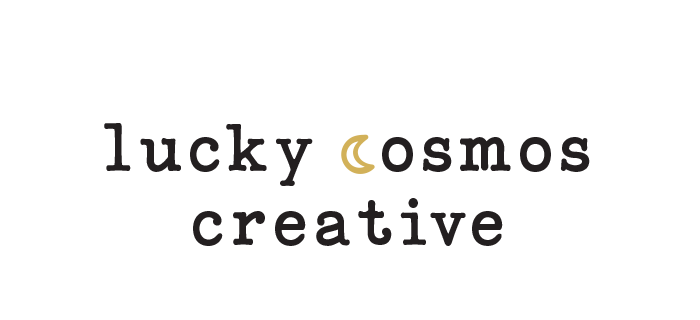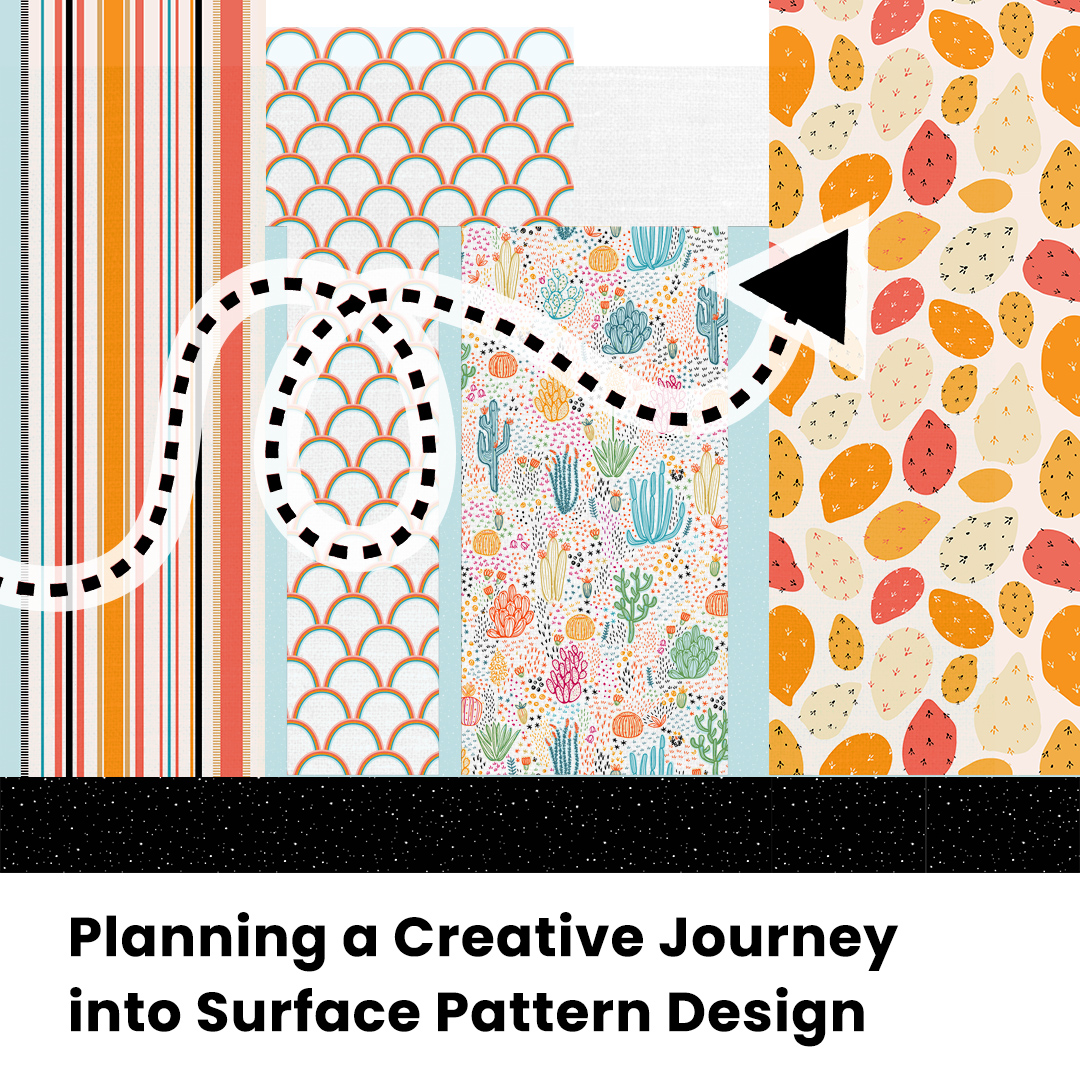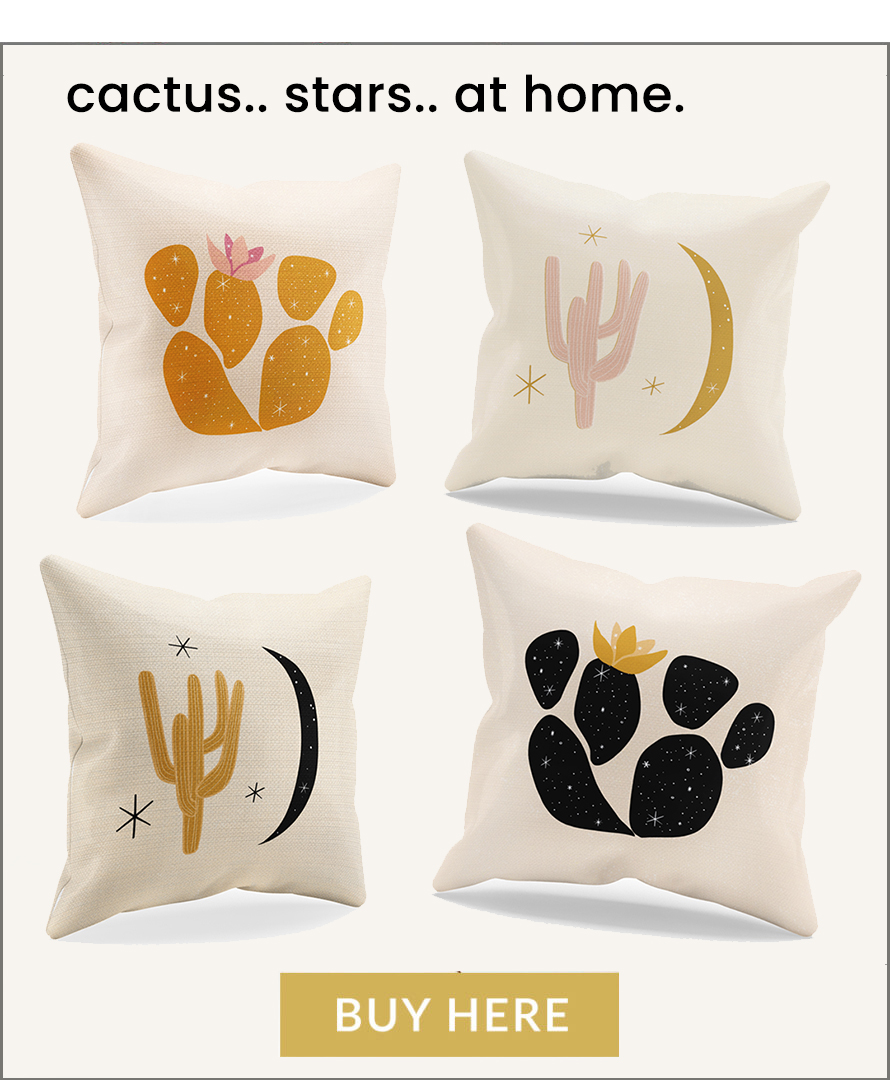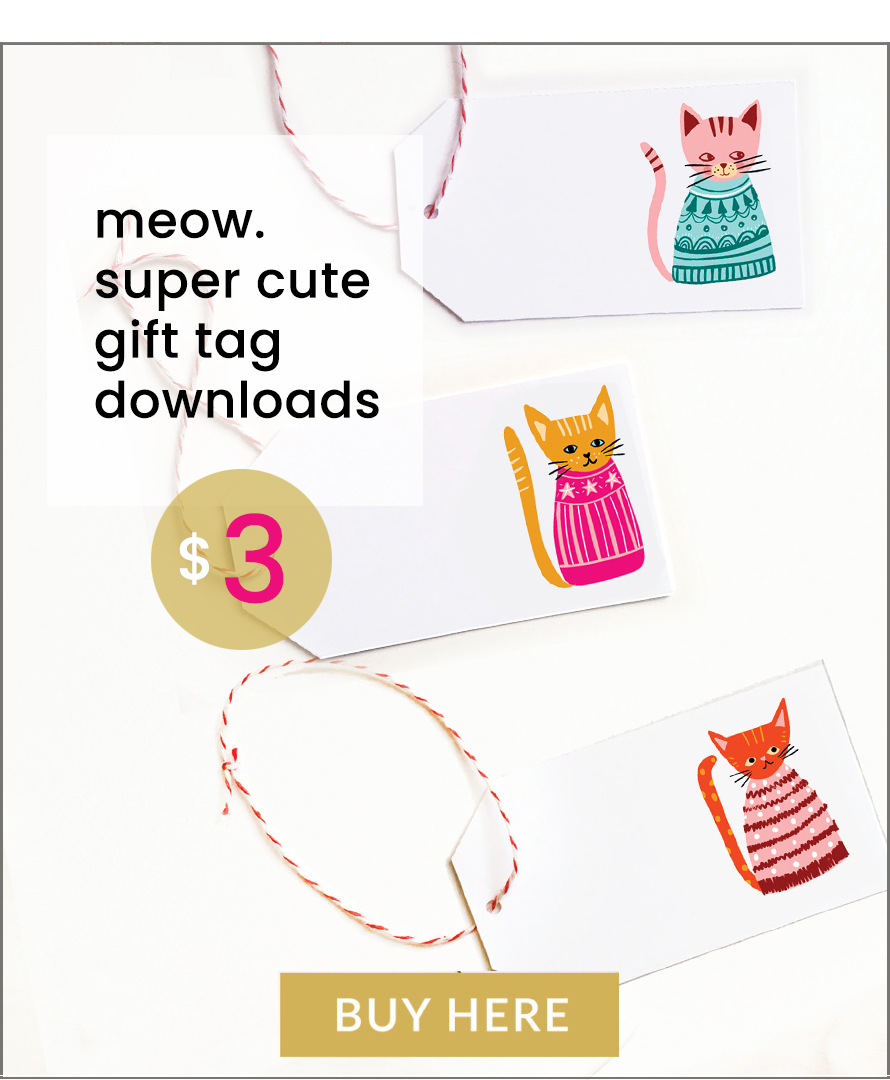New year, new creative journey ✌️
As I sit here on the first day of 2024 looking over some of my goals, I thought this would be a great time to share a few of my plans for my newly reinvigorated creative journey into realizing some pattern design goals this year. Since there really are so few actual surface pattern design jobs out there in the world, I’ll have to make my own.
disclaimer: you may see links to other content providers or companies in this blog post and assume I am earning affiliate income. I wish I was, haha! But not quite yet on these particular links 😉 they’re just there to make your life a little easier..
The road to becoming a licensed surface pattern designer
I started dabbling in illustration and declared myself a pattern designer in late 2019 after spending about 13 years as a commercial graphic designer. Coming from the world of graphic design, it was really confusing to try to hone in on my style. I’d been so adaptive in creating work for others, trying to capture their vision for their marketing materials, that I had developed a lot of different art styles to work with.
I practiced a ton of art styles and eventually pulled myself away from creating hyper realistic imagery (for some reason I was so compelled to capture the stark truth) in favor of more stylized and fun looking motifs.
I’ve been through some major life transitions since I started getting more serious about surface design, and last year I managed to sign myself up for a surface pattern design course that I had wanted to do for a few years. I enrolled in Bonnie Christine’s Surface Design Immersion course and dove into a three month immersive learning experience.
During my time in the course, I was reminded that I really needed to commit to building some habits and getting uncomfortable if I wanted to follow this unwieldy goal through to the golden prize of scoring art licensing and fabric licensing contracts.
I had been voraciously learning about surface pattern design from Skillshare, YouTube, and other surface pattern designers, but going through Immersion brought together all of the pieces. From a deep dive into Illustrator (like DEEP) to color theory, to building pattern collections to creative entrepreneurship.
As a way to honor my time and financial investment in this course, I decided that this year I am prioritizing my dream of seeing my art on products and committing to documenting my creative journey into surface pattern design licensing; taking steps every day, week, month, and quarter to keep moving forward on this dream.
Setting up my surface pattern design goals
My pattern design goals this year include breaking into art licensing by getting an art licensing agreement – or 10. So far, I’ve only licensed one piece of placement art and I would love to make some solid connections in this industry and see my patterns and artwork on products out in the wild.
Like so many of us, my surface design goals are just one of my goals, and I need to prioritize them but not be consumed by them. So I’m going to break up my plan into a few key time-bound bite-sized commitments.
If you are on your own surface pattern themed creative journey, I invite you to follow along if any of these action items feel in alignment and purposeful for you. Whether you start in January or July, getting a timeline in front of you to stay accountable will help you move forward on a dream that has a really convoluted and bumpy path for most of us.. I keep calling this my creative journey because it’s a whole year of commitments – and that’s a long time.
I have been planning my tasks and action items in the free version of Asana, so I plan to give myself tasks with due dates to stay on track with my collection building and pitches. Feel free to do the same on your journey.
I’ll be reporting on my progress quarterly through the blog to keep myself accountable, so if you’re reading this much later, those blog dates will be April 4, 2024, July 4, 2024, and October 3, 2024 (just in case you wanted to follow along and chart your commitments on your own surface design journey).
Okay. Onward? Uh, hehe, yes.. I think so..
Yearlong surface pattern design goals

Below is my single yearlong goal. But it’s a good one..
Committing to one industry for one year
Honestly, sticking to one industry for at least a year will help me build much more of a foundation in a specific market, building better connections than if I continue showering my efforts out over multiple art industries. This is something you can commit to also, if you feel like you’ve been making art for everyone and everything.
What I mean by choosing industries and markets is narrowing down into the general category where you see your art fitting best. You may design in a style that is awesome for baby apparel. If so, I’d stick to baby apparel, baby bedding, and children’s decor – that way your collections maintain this sweet quality, and you’re not trying to design for baby jumpers and stationery both.
I’ve been so swept up in creating art for so many markets – baby clothing, home decor, puzzles, stationery, pet products.. I just love so many forms of art!
This year, I am going to focus on the home decor and home decor gift markets so I can build more and more art that fits into this category.. As I create patterns and placement art with home decor in mind, I can test out some of my designs in my Etsy printed product shop where I have a new-ish section for fun print on demand accent pillows. I’ll be working on getting more art and collections printed on pillows this year, which will motivate me to continue making this home decor themed art.
I’m learning that building a library of license-able artwork within a specific industry works well when you do capture the attention of someone looking for artwork to license. If they’re interested and ask you for more art licensing examples, hopefully you’ve got a few pieces of art in your surface pattern design portfolio that you can shoot over to show your experience in this market.
The above scenario will be more likely if you are concentrating your creative efforts in one industry. I invite you to commit to one market for at least a year also. Especially if you’re a super newbie like me. Since this is my only real yearlong commitment (all of the rest of my commitments will be repeated more than yearly), let’s jump into the quarterly goals next.
Quarterly surface pattern design goals

A year flies by so fast! Setting quarterly goals will allow me to accountable for creating/refining quality work every quarter and following the creative and pitching process through. These are goals I will plunk into my quarterly planning schedule to ensure I complete them.
Focus on building and refining commercial ready collections
Disclaimer: this is a whole feat in and of itself. If I was just starting in surface design, I would honestly spend a year just making art. Making so much art – honing in on my style, which markets are a great fit for my style, etc.
But assuming you’ve been making art (hopefully even some collections) and are now feeling ready to start sharing and pitching your work so you can license your art, now is the time to take stock of your own collections and work on making them commercially ready – full collections prepared as vector files.
How many pieces make up a surface pattern design collection?
Typically a full pattern collection will consist of 10 – 15 pattern design images. A mini collection may be made up of 4 to 8 patterns. Collections are made up of hero prints, coordinating prints and blender prints.
For more detailed information on how to build a full collection with a story and all, check out this post –
Surface Pattern Design Basics for Every Aspiring Pattern Designer
This particular quarter, my focus will be on art that I have already made, refining a couple of my collections from last year, and adding a few coordinating and blender patterns to some hero prints I created that are sort of lonely.. I’m going to do a “collection audit” and decide which collections I want to focus on.
Building marketable surface pattern collections
When creating new collections, it’s worth the time to check out the current motif trends and color trends, even if you avoid trendy things. They’re more likely to be picked up by art licensors since they will fit into an already tested market. Going forward, I’ll be basing my pattern design ideas on things like trends in the home decor market, colors of the year, my own personal joy points, and the individual organizations or clients to whom I’d like to pitch.
Once I decide on the collections I want to develop or refine, I will set up some tasks with due dates to keep myself on track and build out my collections until they feel complete. I like to set a reminder for about 30 minutes a day of SPD art making; when I actually do this, I really stay in a flow and look forward to that quiet drawing time.
When building collections, I do want to have a cohesive style that comes through in all of my pieces. It’s something I constantly work on, as I often veer from a particular style in favor of an effect I want to create in a moment..
Copyrighting surface pattern collections
Though I’m still a little new to this whole art licensing process, one thing I have started doing is making sure to copyright my collections if I really want to license them. To copyright your artwork, just visit www.copyright.org (really important so you can protect yourself if anyone steals your art – and it happens a lot). Selecting the option to license a whole unpublished collection means you can pay one fee to protect up to 10 pieces of the same type of art.
For this reason, I have been aiming for about 10 pieces in my collections as I build and even plan them out. Paying to protect each pattern would get really expensive really fast. So give batching a try to copyright your pattern collections. But you have to make sure you haven’t published your art yet – so apply for your copyright and then you can start publishing your work while you wait for the certificate.
Pitching
Pitching is literally the hardest thing about this creative journey – for me. And because it’s so secretive, so shrouded in mystery, once a designer finds that golden art licensing company or contact, that champion art licensing connector, the relationship is so valuable they don’t want to damage it by spreading that person’s information around. It’s totally understandable.
Art licensing companies are already inundated by so many art licensing submissions that they don’t really want their contact information just floating out there for every aspiring surface pattern designer to find. They’re super busy, and often they have a bank of trusted, vetted artists that they work with, who they know are reliable, consistent, and they can count on the style of their work.
That’s why catching the attention of one of these individuals is pretty tricky, and I believe those who consistently create work, show up, and share their work are the ones who rise to the surface (haha, a punny surface joke!) and get noticed by these creative connectors. (I have to believe this – it’s the thing that keeps me feeling committed to this new bag of commitments).
I’d love to say I am seeking and finding contacts to pitch to every week, but I’m not there – yet. But I can commit to finding and pitching to six new contacts each quarter – and then setting reminders to follow up three weeks later with new work. On first contact, I’ll send one portfolio (or sales sheet) and then follow up with different collection portfolios every month or so..
I know that when I have been in corporate or nonprofit marketing positions, I don’t open every first email from a stranger pitching to me.. So I don’t expect art directors to suddenly trust me upon receiving my first email. But personally, if I keep seeing emails from the same person sharing something I might need, I’ll open them and often respond, even if it’s a “no.” I think a lot of art directors are the same way. Consistency is key to building trust.
Weekly and daily goals and commitments

Scheduling time to create art
This goes hand in hand with working on commercial collections, but I wanted to add it into the weekly/daily commitments because creating and refining art will need to be a very everyday-ish sort of activity for me if I’m truly going to build a big old floating boatload of collections to pitch.
So I commit to spending 30 – 60 minutes 4 days per week working on my artwork – creating art, digitizing art, vectorizing – all the many steps that go into creating license-ready work. I have three collections in mind that I’ll complete and put together in nice portfolios, so this will comprise some of my SPD time also.
What kind of time can you commit to as you work to reach your surface pattern design goals?
Sharing my artwork and art process on social media
Oh heavens. I am a middle aged Gen-X-er literally wishing I could just dance around to The Cure in my own world and only come out when my favorite humans are available to play the old Super Mario Brothers on Nintendo.
But. It turns out I am actually this business-ish woman who has just taken a big risk in jumping soul-first back into this creative business world much more full time, and I am going to have to play in social media land much more than I’m comfy with.
The truth is, I have decided to gather and dispense all of my hopes and dreams into this blog so I can connect with others about creative processes, help other creative business peeps, share my own creative journey and build a business that really grows over time. How can I connect if I am hiding in my midlife day-cave?
So in this moment, I commit to hopping out of my cozy comfort zone and embracing social media like a wild woman. (And today, I just posted one single reel. yay!).
Since I just started this new blog, I am also starting new social media. Like – new social media. Yes, I still have my trusty art instagram account where I share my own personal illustrations, pattern designs and my art from the heart (ever so occasionally these days), but I am starting a brand. spankin.’ new. Instagram account for this Lucky Cosmos Creative blog, and so far, as of writing this I have.. FOUR whole posts and TWO whole followers. (but did you see my clever linking strategy right there? Like – hey! Follow me on the ‘gram, I dare you!)…
How will I tackle this social media strategy, you ask?
I was speaking to a new friend recently who is working with a social media strategist, and one of the assignments she has is to add THREE stories to her Instagram each day. My reaction: Y’all. Three? THREE. Three stories a day? Eep!
But… I’m going to venture into some of these wildly uncomfortable social media story shenanigans. I’m going to let this be the place where I stop curating so much, (like on my personal art account), and start sharing possibly ridiculously random daily things – cool packaging on tea.. a mural.. a bug.. a moment of sunshine on a winter afternoon.
What a way to force an artist to stop being so precious about sharing, right? In the art world, there’s a little gem of wisdom, and it goes a little like this: share the turds. You know? Share the s#itty pieces of art that never made it into a frame or even into the light of day. Share the process. Share the things that don’t work. Share the turds.
So here I am. Sharing some turds. Maybe three a day. 💩💩💩 And also some little golden nuggets (non-poo nuggets). I guess it’ll just be a crapshoot..
I’m a little excited to be honest.. I’ve been a solopreneur for almost two decades, and I sometimes try really hard to be “that professional kinda gal,” ya know? And if you don’t know this about me yet, I’m a little bit of a strange duck. I’ve become sick of trying to behave, and if I’m posting multiple daily stories, I’m gonna have to fly my “me” flag on the ‘gram.
And maybe that flag is actually a cute little pattern of my own creation, just flying and whipping in the sunshine like the floral glory it was born to be.
So I’ll drop this here – I commit to being much more real, much less precious and curated, bringing more me-ness, and posting a story – or a turd or three – 5 ish days each week. I also commit to spending 10 minutes each day liking and commenting on other awesome creative content out there; making friends in the community you might say.
So that sums up my creative journey plan for leaping and bounding toward my surface pattern goals. I’ll do a little tally of my commitments below so I can hold myself accountable and give my next update at the beginning of April.
Creative journey benchmarks and commitments over the next year:

Yearlong commitment:
- I commit to designing for and pitching to ONE surface pattern industry this year: the Home Decor and Home Gift markets (is that really two?? shhh)
Quarterly commitments:
- Focus on a collection each quarter
- building, refining and refreshing at least one collection
- Pitch to 6 different contacts each quarter
- And set reminders to follow up with each of them every month. This will become a larger chunk of time considering all of the follow up – but pitching is a numbers game and the more pitches I send, the higher my chances of someday rejoicing with you because I FINALLY got that licensing agreement with Blue Q..
Weekly/Daily commitments:
- Create a LOT of art
- 30 – 60 minutes 4 days per week of working on art for surface design collections or placement art. Not pitching or formatting portfolios, just art.
- Put on my brave and exciting social media cap:
- Post 1 – 3 stories 5+ days per week
- Like and comment on posts in my community for 10 minutes daily
- Post 4+ reels per week
- Share real life shenanigans, mistakes, joys, moments
- Share blog posts, promote products occasionally
Annnnnd, that’s the list. No bigs, right? 🤡
Friends, this feels like a heavy lift, but becoming a real live licensed surface pattern designer which is my longest held professional dream, so I’m going to weight that really heavily in 2024. If becoming a licensed designer is a dream in your heart, I hope you’ll follow along in whatever capacity you have. I know we all have different lives and margins of time, but I’ll borrow a little token of wisdom from the Bonnie Christine Immersion course and say, “just do one thing a day.”
Doing one thing a day, whether it’s five minutes or five hours will keep you (and me!) moving toward reaching this goal that feels like it’s locked in a fortress of far away surface wonder. We’ll both get there, friends, and if you have any wins to share I’d love to hear about them! Feel free to connect with me at hello@luckycosmoscreative.com; no need to share anything proprietary – just designer to designer rejoicing in a win 🙂
Take care out there, and I hope to see you around on this awesome patterned path of a creative journey into surface pattern licensing blissssssss!!
I hope you enjoyed this post about setting up time bound benchmarks on a creative journey of making dreams come true.



